The Ethical Issues Surrounding International Drug Pricing Practices
VerifiedAdded on 2022/08/20
|7
|1874
|13
Essay
AI Summary
This essay delves into the ethical issues surrounding international drug pricing, examining the factors that contribute to high pharmaceutical costs, such as research and development expenses, patent exclusivity, and market dynamics. It uses AZT as a case study to highlight the ethical concerns of exorbitant drug prices and their impact on patient access, particularly for those without insurance. The paper discusses how countries like Germany, France, the UK, and Sweden regulate drug prices through legislative controls and national health insurance systems. It then proposes alternative solutions for the United States, including price negotiations, value-based pricing assessments, and measures to reduce loopholes in patent laws, aiming to make drugs more affordable and accessible while ensuring fair practices within the pharmaceutical industry. The conclusion emphasizes the need for a balanced approach, drawing from international models and adapting them to the specific context of the U.S. healthcare system.
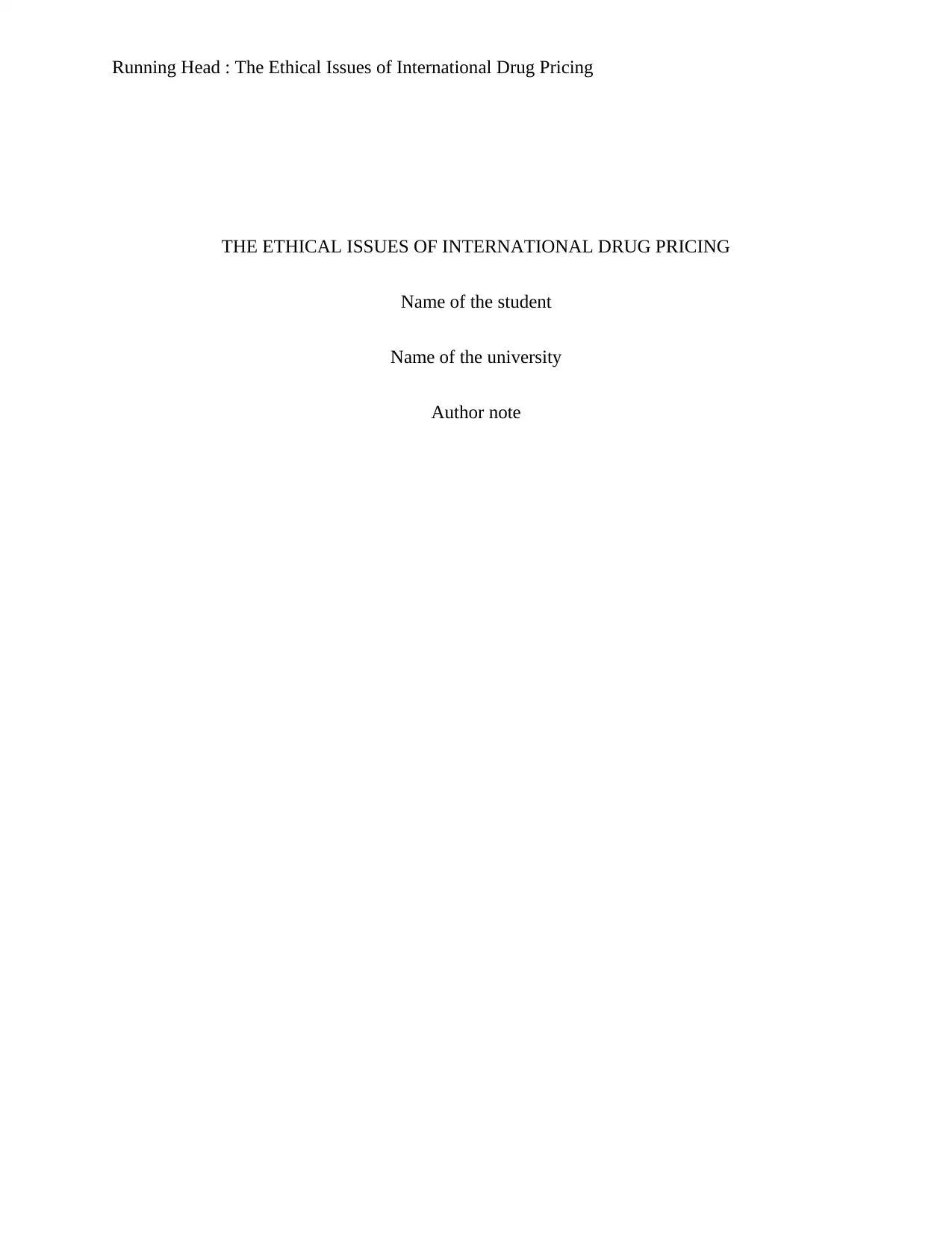
Running Head : The Ethical Issues of International Drug Pricing
THE ETHICAL ISSUES OF INTERNATIONAL DRUG PRICING
Name of the student
Name of the university
Author note
THE ETHICAL ISSUES OF INTERNATIONAL DRUG PRICING
Name of the student
Name of the university
Author note
Paraphrase This Document
Need a fresh take? Get an instant paraphrase of this document with our AI Paraphraser
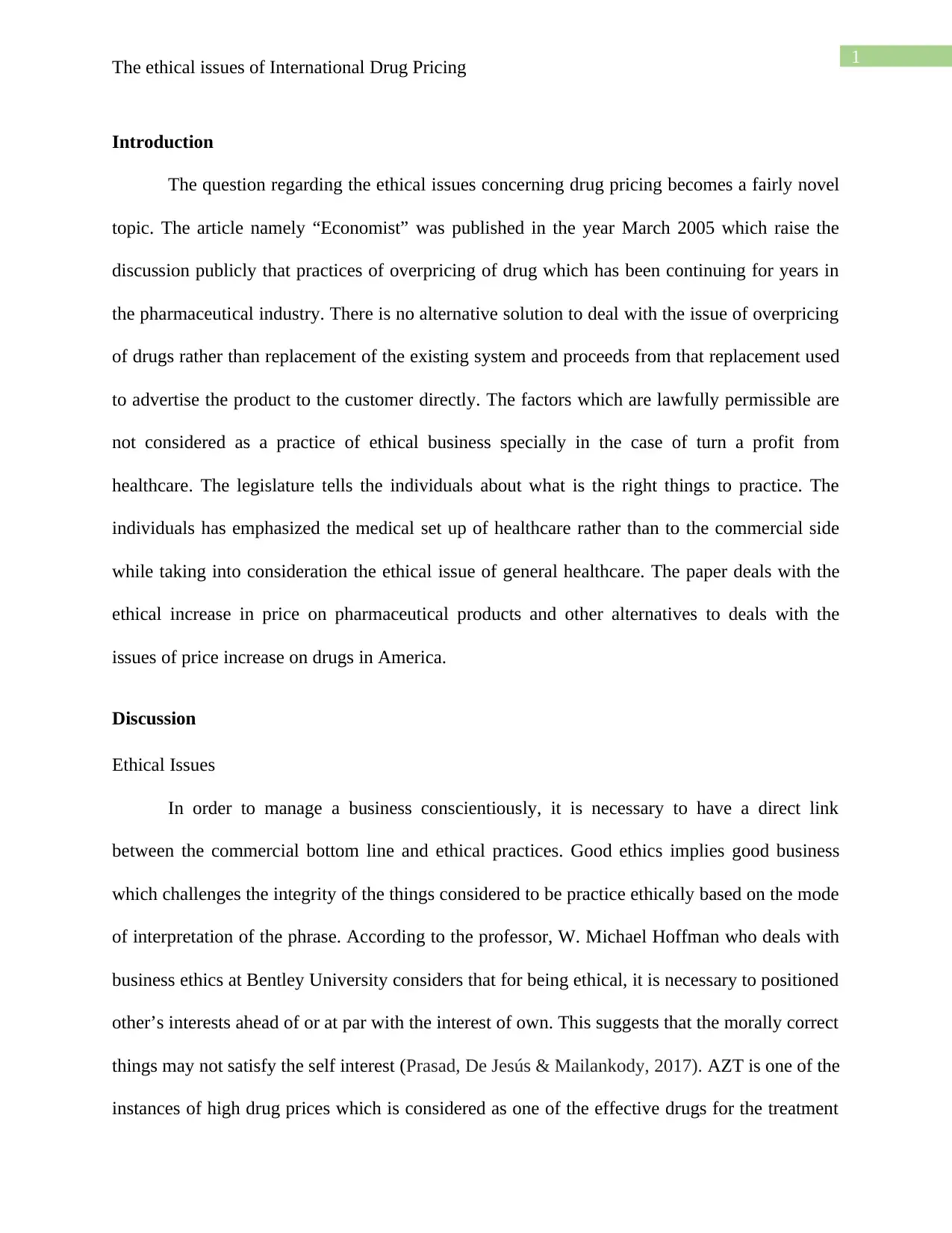
1
The ethical issues of International Drug Pricing
Introduction
The question regarding the ethical issues concerning drug pricing becomes a fairly novel
topic. The article namely “Economist” was published in the year March 2005 which raise the
discussion publicly that practices of overpricing of drug which has been continuing for years in
the pharmaceutical industry. There is no alternative solution to deal with the issue of overpricing
of drugs rather than replacement of the existing system and proceeds from that replacement used
to advertise the product to the customer directly. The factors which are lawfully permissible are
not considered as a practice of ethical business specially in the case of turn a profit from
healthcare. The legislature tells the individuals about what is the right things to practice. The
individuals has emphasized the medical set up of healthcare rather than to the commercial side
while taking into consideration the ethical issue of general healthcare. The paper deals with the
ethical increase in price on pharmaceutical products and other alternatives to deals with the
issues of price increase on drugs in America.
Discussion
Ethical Issues
In order to manage a business conscientiously, it is necessary to have a direct link
between the commercial bottom line and ethical practices. Good ethics implies good business
which challenges the integrity of the things considered to be practice ethically based on the mode
of interpretation of the phrase. According to the professor, W. Michael Hoffman who deals with
business ethics at Bentley University considers that for being ethical, it is necessary to positioned
other’s interests ahead of or at par with the interest of own. This suggests that the morally correct
things may not satisfy the self interest (Prasad, De Jesús & Mailankody, 2017). AZT is one of the
instances of high drug prices which is considered as one of the effective drugs for the treatment
The ethical issues of International Drug Pricing
Introduction
The question regarding the ethical issues concerning drug pricing becomes a fairly novel
topic. The article namely “Economist” was published in the year March 2005 which raise the
discussion publicly that practices of overpricing of drug which has been continuing for years in
the pharmaceutical industry. There is no alternative solution to deal with the issue of overpricing
of drugs rather than replacement of the existing system and proceeds from that replacement used
to advertise the product to the customer directly. The factors which are lawfully permissible are
not considered as a practice of ethical business specially in the case of turn a profit from
healthcare. The legislature tells the individuals about what is the right things to practice. The
individuals has emphasized the medical set up of healthcare rather than to the commercial side
while taking into consideration the ethical issue of general healthcare. The paper deals with the
ethical increase in price on pharmaceutical products and other alternatives to deals with the
issues of price increase on drugs in America.
Discussion
Ethical Issues
In order to manage a business conscientiously, it is necessary to have a direct link
between the commercial bottom line and ethical practices. Good ethics implies good business
which challenges the integrity of the things considered to be practice ethically based on the mode
of interpretation of the phrase. According to the professor, W. Michael Hoffman who deals with
business ethics at Bentley University considers that for being ethical, it is necessary to positioned
other’s interests ahead of or at par with the interest of own. This suggests that the morally correct
things may not satisfy the self interest (Prasad, De Jesús & Mailankody, 2017). AZT is one of the
instances of high drug prices which is considered as one of the effective drugs for the treatment
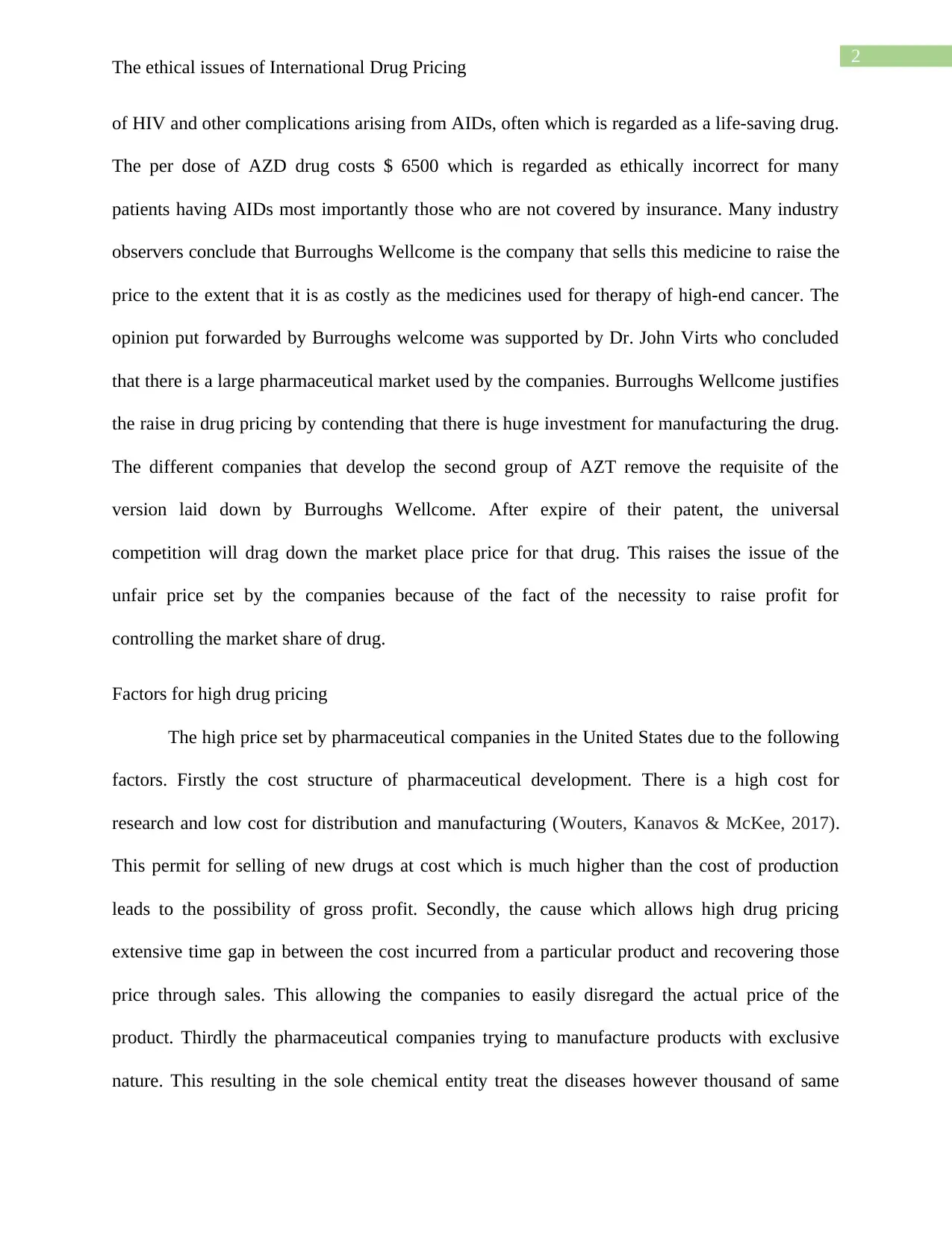
2
The ethical issues of International Drug Pricing
of HIV and other complications arising from AIDs, often which is regarded as a life-saving drug.
The per dose of AZD drug costs $ 6500 which is regarded as ethically incorrect for many
patients having AIDs most importantly those who are not covered by insurance. Many industry
observers conclude that Burroughs Wellcome is the company that sells this medicine to raise the
price to the extent that it is as costly as the medicines used for therapy of high-end cancer. The
opinion put forwarded by Burroughs welcome was supported by Dr. John Virts who concluded
that there is a large pharmaceutical market used by the companies. Burroughs Wellcome justifies
the raise in drug pricing by contending that there is huge investment for manufacturing the drug.
The different companies that develop the second group of AZT remove the requisite of the
version laid down by Burroughs Wellcome. After expire of their patent, the universal
competition will drag down the market place price for that drug. This raises the issue of the
unfair price set by the companies because of the fact of the necessity to raise profit for
controlling the market share of drug.
Factors for high drug pricing
The high price set by pharmaceutical companies in the United States due to the following
factors. Firstly the cost structure of pharmaceutical development. There is a high cost for
research and low cost for distribution and manufacturing (Wouters, Kanavos & McKee, 2017).
This permit for selling of new drugs at cost which is much higher than the cost of production
leads to the possibility of gross profit. Secondly, the cause which allows high drug pricing
extensive time gap in between the cost incurred from a particular product and recovering those
price through sales. This allowing the companies to easily disregard the actual price of the
product. Thirdly the pharmaceutical companies trying to manufacture products with exclusive
nature. This resulting in the sole chemical entity treat the diseases however thousand of same
The ethical issues of International Drug Pricing
of HIV and other complications arising from AIDs, often which is regarded as a life-saving drug.
The per dose of AZD drug costs $ 6500 which is regarded as ethically incorrect for many
patients having AIDs most importantly those who are not covered by insurance. Many industry
observers conclude that Burroughs Wellcome is the company that sells this medicine to raise the
price to the extent that it is as costly as the medicines used for therapy of high-end cancer. The
opinion put forwarded by Burroughs welcome was supported by Dr. John Virts who concluded
that there is a large pharmaceutical market used by the companies. Burroughs Wellcome justifies
the raise in drug pricing by contending that there is huge investment for manufacturing the drug.
The different companies that develop the second group of AZT remove the requisite of the
version laid down by Burroughs Wellcome. After expire of their patent, the universal
competition will drag down the market place price for that drug. This raises the issue of the
unfair price set by the companies because of the fact of the necessity to raise profit for
controlling the market share of drug.
Factors for high drug pricing
The high price set by pharmaceutical companies in the United States due to the following
factors. Firstly the cost structure of pharmaceutical development. There is a high cost for
research and low cost for distribution and manufacturing (Wouters, Kanavos & McKee, 2017).
This permit for selling of new drugs at cost which is much higher than the cost of production
leads to the possibility of gross profit. Secondly, the cause which allows high drug pricing
extensive time gap in between the cost incurred from a particular product and recovering those
price through sales. This allowing the companies to easily disregard the actual price of the
product. Thirdly the pharmaceutical companies trying to manufacture products with exclusive
nature. This resulting in the sole chemical entity treat the diseases however thousand of same
⊘ This is a preview!⊘
Do you want full access?
Subscribe today to unlock all pages.

Trusted by 1+ million students worldwide
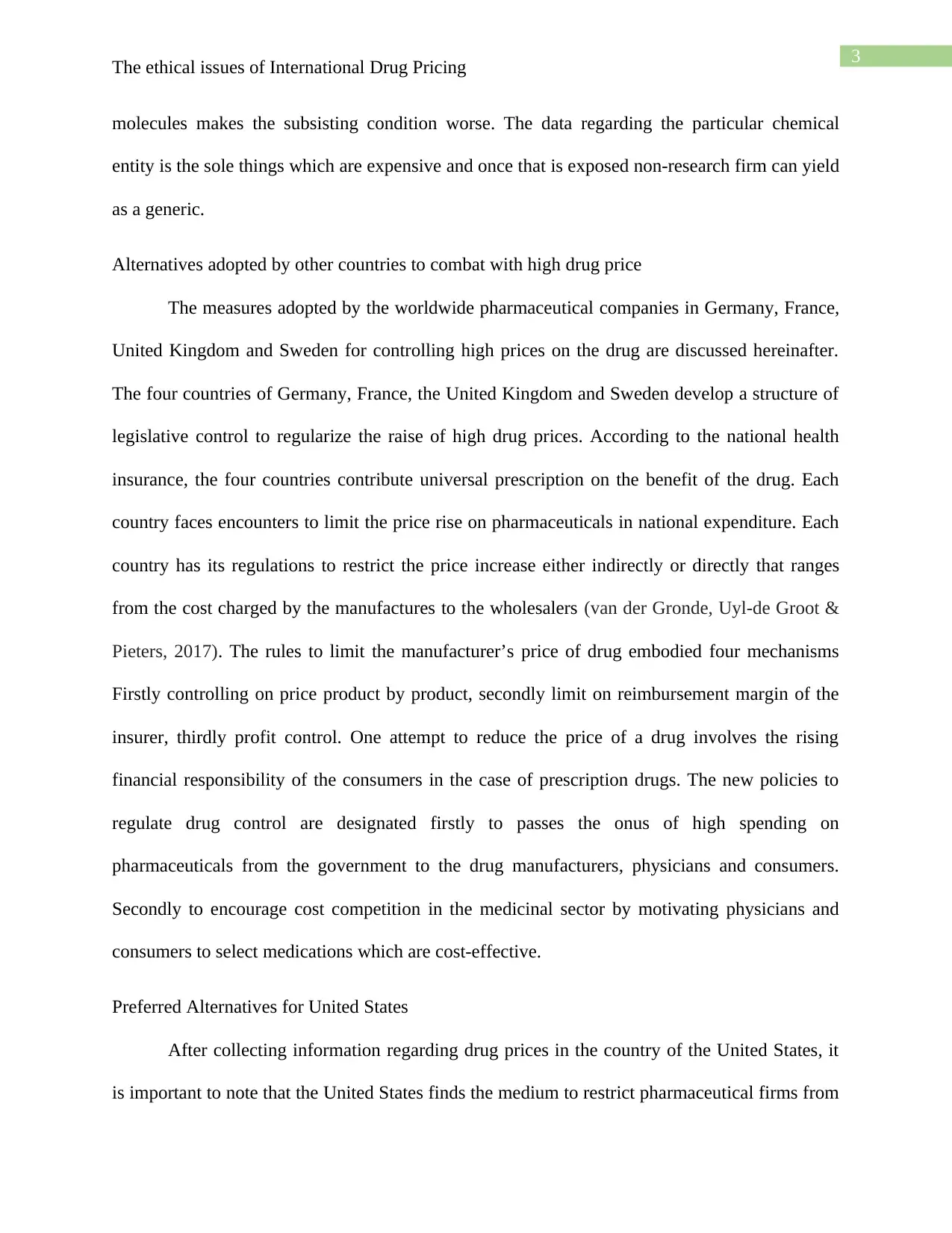
3
The ethical issues of International Drug Pricing
molecules makes the subsisting condition worse. The data regarding the particular chemical
entity is the sole things which are expensive and once that is exposed non-research firm can yield
as a generic.
Alternatives adopted by other countries to combat with high drug price
The measures adopted by the worldwide pharmaceutical companies in Germany, France,
United Kingdom and Sweden for controlling high prices on the drug are discussed hereinafter.
The four countries of Germany, France, the United Kingdom and Sweden develop a structure of
legislative control to regularize the raise of high drug prices. According to the national health
insurance, the four countries contribute universal prescription on the benefit of the drug. Each
country faces encounters to limit the price rise on pharmaceuticals in national expenditure. Each
country has its regulations to restrict the price increase either indirectly or directly that ranges
from the cost charged by the manufactures to the wholesalers (van der Gronde, Uyl-de Groot &
Pieters, 2017). The rules to limit the manufacturer’s price of drug embodied four mechanisms
Firstly controlling on price product by product, secondly limit on reimbursement margin of the
insurer, thirdly profit control. One attempt to reduce the price of a drug involves the rising
financial responsibility of the consumers in the case of prescription drugs. The new policies to
regulate drug control are designated firstly to passes the onus of high spending on
pharmaceuticals from the government to the drug manufacturers, physicians and consumers.
Secondly to encourage cost competition in the medicinal sector by motivating physicians and
consumers to select medications which are cost-effective.
Preferred Alternatives for United States
After collecting information regarding drug prices in the country of the United States, it
is important to note that the United States finds the medium to restrict pharmaceutical firms from
The ethical issues of International Drug Pricing
molecules makes the subsisting condition worse. The data regarding the particular chemical
entity is the sole things which are expensive and once that is exposed non-research firm can yield
as a generic.
Alternatives adopted by other countries to combat with high drug price
The measures adopted by the worldwide pharmaceutical companies in Germany, France,
United Kingdom and Sweden for controlling high prices on the drug are discussed hereinafter.
The four countries of Germany, France, the United Kingdom and Sweden develop a structure of
legislative control to regularize the raise of high drug prices. According to the national health
insurance, the four countries contribute universal prescription on the benefit of the drug. Each
country faces encounters to limit the price rise on pharmaceuticals in national expenditure. Each
country has its regulations to restrict the price increase either indirectly or directly that ranges
from the cost charged by the manufactures to the wholesalers (van der Gronde, Uyl-de Groot &
Pieters, 2017). The rules to limit the manufacturer’s price of drug embodied four mechanisms
Firstly controlling on price product by product, secondly limit on reimbursement margin of the
insurer, thirdly profit control. One attempt to reduce the price of a drug involves the rising
financial responsibility of the consumers in the case of prescription drugs. The new policies to
regulate drug control are designated firstly to passes the onus of high spending on
pharmaceuticals from the government to the drug manufacturers, physicians and consumers.
Secondly to encourage cost competition in the medicinal sector by motivating physicians and
consumers to select medications which are cost-effective.
Preferred Alternatives for United States
After collecting information regarding drug prices in the country of the United States, it
is important to note that the United States finds the medium to restrict pharmaceutical firms from
Paraphrase This Document
Need a fresh take? Get an instant paraphrase of this document with our AI Paraphraser
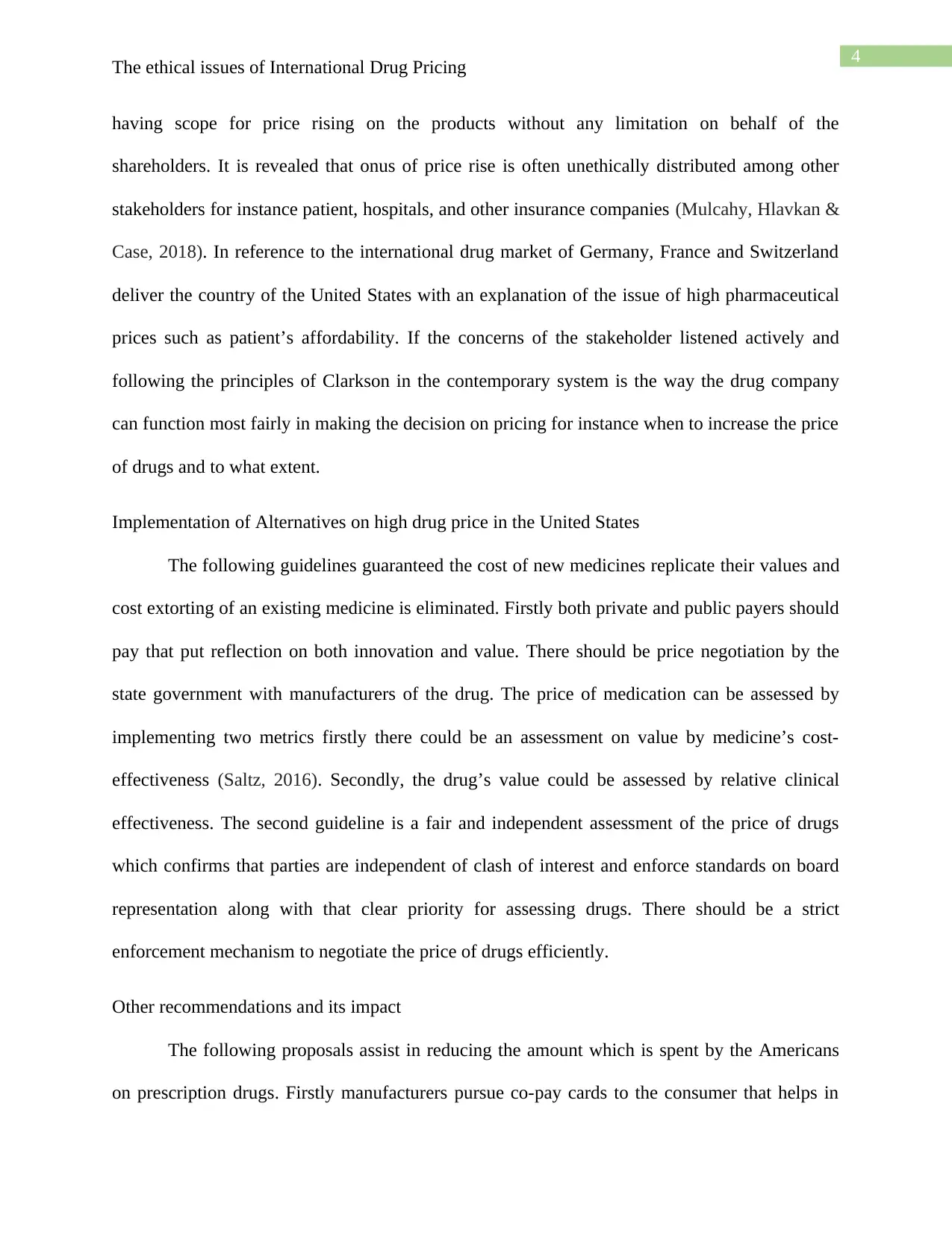
4
The ethical issues of International Drug Pricing
having scope for price rising on the products without any limitation on behalf of the
shareholders. It is revealed that onus of price rise is often unethically distributed among other
stakeholders for instance patient, hospitals, and other insurance companies (Mulcahy, Hlavkan &
Case, 2018). In reference to the international drug market of Germany, France and Switzerland
deliver the country of the United States with an explanation of the issue of high pharmaceutical
prices such as patient’s affordability. If the concerns of the stakeholder listened actively and
following the principles of Clarkson in the contemporary system is the way the drug company
can function most fairly in making the decision on pricing for instance when to increase the price
of drugs and to what extent.
Implementation of Alternatives on high drug price in the United States
The following guidelines guaranteed the cost of new medicines replicate their values and
cost extorting of an existing medicine is eliminated. Firstly both private and public payers should
pay that put reflection on both innovation and value. There should be price negotiation by the
state government with manufacturers of the drug. The price of medication can be assessed by
implementing two metrics firstly there could be an assessment on value by medicine’s cost-
effectiveness (Saltz, 2016). Secondly, the drug’s value could be assessed by relative clinical
effectiveness. The second guideline is a fair and independent assessment of the price of drugs
which confirms that parties are independent of clash of interest and enforce standards on board
representation along with that clear priority for assessing drugs. There should be a strict
enforcement mechanism to negotiate the price of drugs efficiently.
Other recommendations and its impact
The following proposals assist in reducing the amount which is spent by the Americans
on prescription drugs. Firstly manufacturers pursue co-pay cards to the consumer that helps in
The ethical issues of International Drug Pricing
having scope for price rising on the products without any limitation on behalf of the
shareholders. It is revealed that onus of price rise is often unethically distributed among other
stakeholders for instance patient, hospitals, and other insurance companies (Mulcahy, Hlavkan &
Case, 2018). In reference to the international drug market of Germany, France and Switzerland
deliver the country of the United States with an explanation of the issue of high pharmaceutical
prices such as patient’s affordability. If the concerns of the stakeholder listened actively and
following the principles of Clarkson in the contemporary system is the way the drug company
can function most fairly in making the decision on pricing for instance when to increase the price
of drugs and to what extent.
Implementation of Alternatives on high drug price in the United States
The following guidelines guaranteed the cost of new medicines replicate their values and
cost extorting of an existing medicine is eliminated. Firstly both private and public payers should
pay that put reflection on both innovation and value. There should be price negotiation by the
state government with manufacturers of the drug. The price of medication can be assessed by
implementing two metrics firstly there could be an assessment on value by medicine’s cost-
effectiveness (Saltz, 2016). Secondly, the drug’s value could be assessed by relative clinical
effectiveness. The second guideline is a fair and independent assessment of the price of drugs
which confirms that parties are independent of clash of interest and enforce standards on board
representation along with that clear priority for assessing drugs. There should be a strict
enforcement mechanism to negotiate the price of drugs efficiently.
Other recommendations and its impact
The following proposals assist in reducing the amount which is spent by the Americans
on prescription drugs. Firstly manufacturers pursue co-pay cards to the consumer that helps in
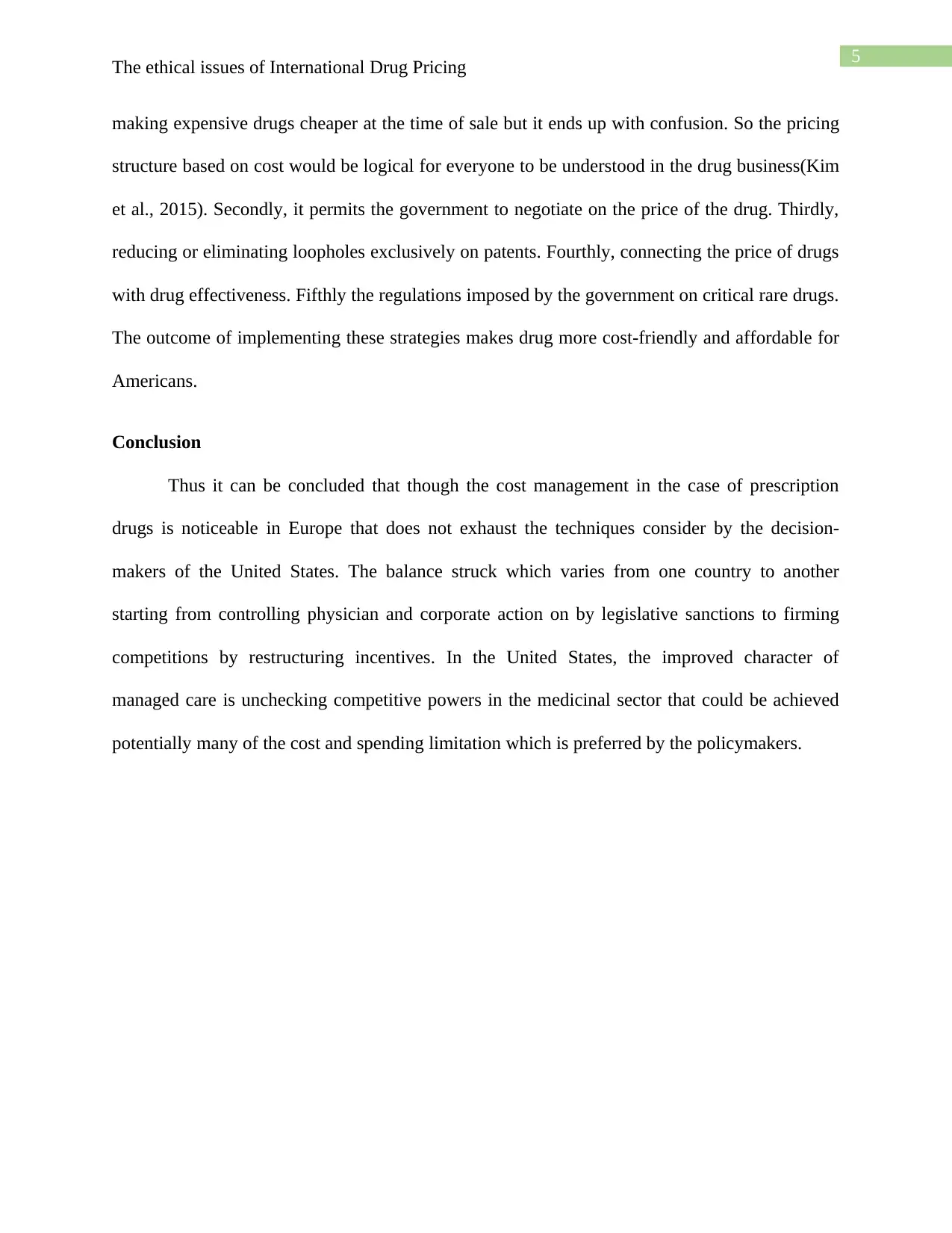
5
The ethical issues of International Drug Pricing
making expensive drugs cheaper at the time of sale but it ends up with confusion. So the pricing
structure based on cost would be logical for everyone to be understood in the drug business(Kim
et al., 2015). Secondly, it permits the government to negotiate on the price of the drug. Thirdly,
reducing or eliminating loopholes exclusively on patents. Fourthly, connecting the price of drugs
with drug effectiveness. Fifthly the regulations imposed by the government on critical rare drugs.
The outcome of implementing these strategies makes drug more cost-friendly and affordable for
Americans.
Conclusion
Thus it can be concluded that though the cost management in the case of prescription
drugs is noticeable in Europe that does not exhaust the techniques consider by the decision-
makers of the United States. The balance struck which varies from one country to another
starting from controlling physician and corporate action on by legislative sanctions to firming
competitions by restructuring incentives. In the United States, the improved character of
managed care is unchecking competitive powers in the medicinal sector that could be achieved
potentially many of the cost and spending limitation which is preferred by the policymakers.
The ethical issues of International Drug Pricing
making expensive drugs cheaper at the time of sale but it ends up with confusion. So the pricing
structure based on cost would be logical for everyone to be understood in the drug business(Kim
et al., 2015). Secondly, it permits the government to negotiate on the price of the drug. Thirdly,
reducing or eliminating loopholes exclusively on patents. Fourthly, connecting the price of drugs
with drug effectiveness. Fifthly the regulations imposed by the government on critical rare drugs.
The outcome of implementing these strategies makes drug more cost-friendly and affordable for
Americans.
Conclusion
Thus it can be concluded that though the cost management in the case of prescription
drugs is noticeable in Europe that does not exhaust the techniques consider by the decision-
makers of the United States. The balance struck which varies from one country to another
starting from controlling physician and corporate action on by legislative sanctions to firming
competitions by restructuring incentives. In the United States, the improved character of
managed care is unchecking competitive powers in the medicinal sector that could be achieved
potentially many of the cost and spending limitation which is preferred by the policymakers.
⊘ This is a preview!⊘
Do you want full access?
Subscribe today to unlock all pages.

Trusted by 1+ million students worldwide
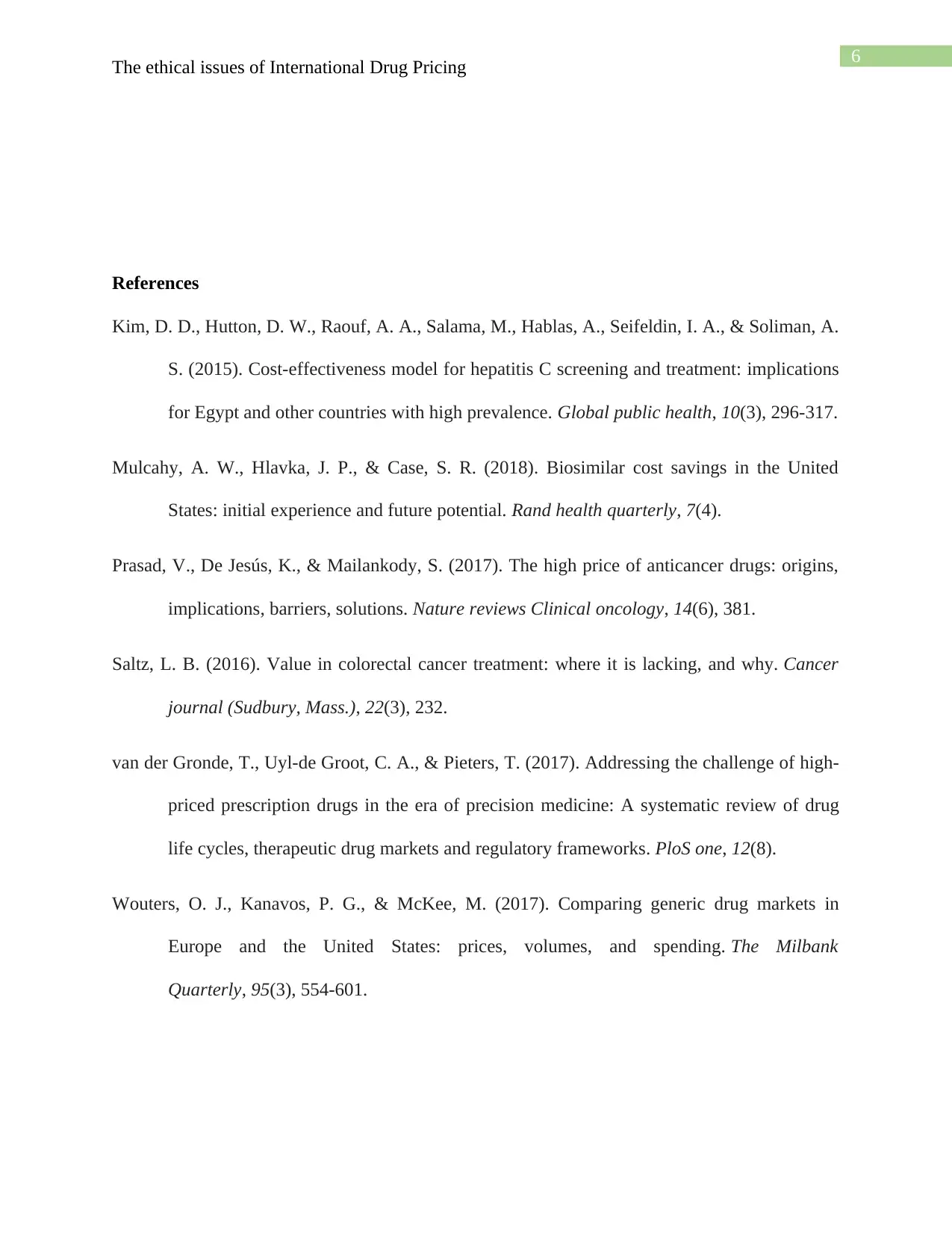
6
The ethical issues of International Drug Pricing
References
Kim, D. D., Hutton, D. W., Raouf, A. A., Salama, M., Hablas, A., Seifeldin, I. A., & Soliman, A.
S. (2015). Cost-effectiveness model for hepatitis C screening and treatment: implications
for Egypt and other countries with high prevalence. Global public health, 10(3), 296-317.
Mulcahy, A. W., Hlavka, J. P., & Case, S. R. (2018). Biosimilar cost savings in the United
States: initial experience and future potential. Rand health quarterly, 7(4).
Prasad, V., De Jesús, K., & Mailankody, S. (2017). The high price of anticancer drugs: origins,
implications, barriers, solutions. Nature reviews Clinical oncology, 14(6), 381.
Saltz, L. B. (2016). Value in colorectal cancer treatment: where it is lacking, and why. Cancer
journal (Sudbury, Mass.), 22(3), 232.
van der Gronde, T., Uyl-de Groot, C. A., & Pieters, T. (2017). Addressing the challenge of high-
priced prescription drugs in the era of precision medicine: A systematic review of drug
life cycles, therapeutic drug markets and regulatory frameworks. PloS one, 12(8).
Wouters, O. J., Kanavos, P. G., & McKee, M. (2017). Comparing generic drug markets in
Europe and the United States: prices, volumes, and spending. The Milbank
Quarterly, 95(3), 554-601.
The ethical issues of International Drug Pricing
References
Kim, D. D., Hutton, D. W., Raouf, A. A., Salama, M., Hablas, A., Seifeldin, I. A., & Soliman, A.
S. (2015). Cost-effectiveness model for hepatitis C screening and treatment: implications
for Egypt and other countries with high prevalence. Global public health, 10(3), 296-317.
Mulcahy, A. W., Hlavka, J. P., & Case, S. R. (2018). Biosimilar cost savings in the United
States: initial experience and future potential. Rand health quarterly, 7(4).
Prasad, V., De Jesús, K., & Mailankody, S. (2017). The high price of anticancer drugs: origins,
implications, barriers, solutions. Nature reviews Clinical oncology, 14(6), 381.
Saltz, L. B. (2016). Value in colorectal cancer treatment: where it is lacking, and why. Cancer
journal (Sudbury, Mass.), 22(3), 232.
van der Gronde, T., Uyl-de Groot, C. A., & Pieters, T. (2017). Addressing the challenge of high-
priced prescription drugs in the era of precision medicine: A systematic review of drug
life cycles, therapeutic drug markets and regulatory frameworks. PloS one, 12(8).
Wouters, O. J., Kanavos, P. G., & McKee, M. (2017). Comparing generic drug markets in
Europe and the United States: prices, volumes, and spending. The Milbank
Quarterly, 95(3), 554-601.
1 out of 7
Related Documents
Your All-in-One AI-Powered Toolkit for Academic Success.
+13062052269
info@desklib.com
Available 24*7 on WhatsApp / Email
![[object Object]](/_next/static/media/star-bottom.7253800d.svg)
Unlock your academic potential
Copyright © 2020–2025 A2Z Services. All Rights Reserved. Developed and managed by ZUCOL.



